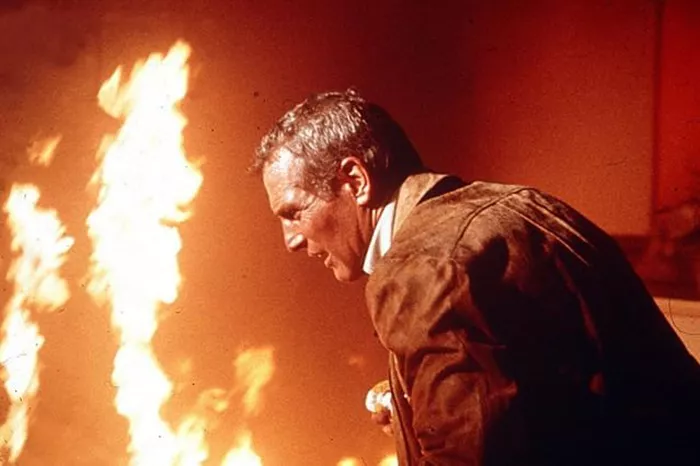As part of a series where writers share their favorite comfort films, this article revisits the thrilling 1974 disaster classic The Towering Inferno and explores why it remains my happiest movie.
One of many reasons I probably should have sought therapy long ago is that I find comfort in a film about a group of people trapped inside a burning skyscraper. But that’s the truth: unforgettable special effects, a massive and legendary cast, suspense over who will survive, and a heartfelt yet cliché line — whenever I feel anxious or down, The Towering Inferno always manages to soothe me.
The most obvious reason is nostalgia. My parents were avid moviegoers who regularly took us to the cinema every week. This was no ordinary outing. The Towering Inferno was the pinnacle of the 1970s disaster movie craze, often dismissed by critics as lowbrow (though they admitted it was pure entertainment). It became a hot topic at school — whose parents were so cool as to take their kids to such a spectacle? This made it one of my earliest cinematic memories, tied to the joyful experience of going to the movies with my parents.
When I began studying film at university, my appreciation deepened. Analysis showed that audiences lined up to see this 1974 box office champion because it reminded them of America itself — a nation reeling from the Vietnam War, Watergate, racial tensions, and a series of political assassinations. The disaster movie’s star-studded cast featured familiar faces with whom everyone could identify.
Rewatching this film and others from the ’70s, I realized they also reflected a clash between old Hollywood and the emerging New Hollywood. Young directors were breaking conventions, independent production was growing, the old Hayes Code was defunct, and the studio system was changing. The film united old-guard stars like Fred Astaire, Jennifer Jones, and the conservative William Holden with New Hollywood icons such as Steve McQueen, Paul Newman — who proudly counted himself on Nixon’s enemies list — and Faye Dunaway, who was heralded as a breakthrough figure seven years earlier with Bonnie and Clyde.
Each star carried their own mini-narrative: Would the ambitious reporter (Dunaway) sacrifice her career for love? (Her lover played by Newman — do we even need to ask?) Would the con man (Astaire) admit to his new flame (Jones) that he initially intended to deceive her? And really, with O.J. Simpson as the security chief, was anyone truly safe? The film is packed with stars — even a young Mike Lookinland from The Brady Bunch appears as the precocious child — making it feel like watching Hollywood Squares descend into chaos.
The actors endured not only the sweltering heat but also some numbingly bad dialogue. When the secretary (Susan Flannery) has a secret romance with the building’s PR man (Robert Wagner), she faces the possibility of burning alive and says, “Well, I always wanted to die in my bed.” How anyone survived such a script is beyond me. These lines, though cringe-worthy, have become a source of affectionate mockery.
The significance of each actor became clearer as I delved further into film studies. British writer Richard Dyer, in his seminal 1979 book Stars, analyzed the ideological meaning of Hollywood celebrities. When I discussed his work with him, Dyer acknowledged that The Towering Inferno — with its complex and sometimes conflicting star symbolism — partly inspired his ideas.
If the film is charged with the tension of old versus new, its creators clearly belonged to the old school. The movie reminds us that even in turbulent times, American heroism, embodied by square-jawed leading men, remains vibrant. Yes, America and Hollywood have their flaws and greedy villains, but ultimately there are brave survivors — the people will prevail. Despite deep divisions, villains (real or fictional), and brutal disasters, kindness persists. Even in a fractured America, collective challenges remind us we are in this together — and amid the turbulent decade’s ruins, miracles can still happen. More than a decade after the Cuban Missile Crisis, the film’s final crane shot revealing survivors is itself astonishing.
In retrospect, it feels like the right time to watch The Towering Inferno again.
The Towering Inferno is currently available to buy digitally in the U.S. and to rent digitally in the U.K.
Related Topics:
- The Best Transformers Scenes Are in Bumblebee
- Hunter Schafer Eyed as Princess Zelda in Live-Action Film
- The Howling: The Overlooked Werewolf Film of 1981

